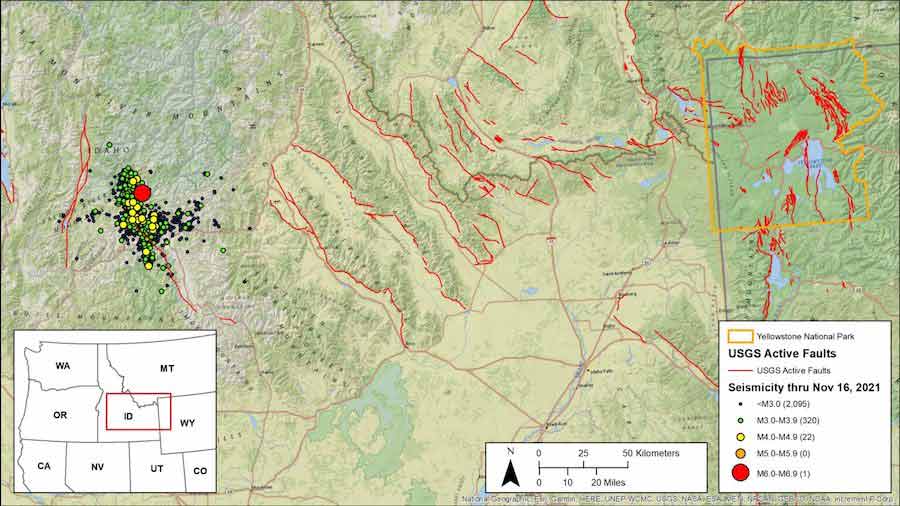Will the earthquakes in central Idaho cause the Yellowstone volcano to erupt?
Published at | Updated at
YELLOWSTONE NATIONAL PARK (Idaho Capital Sun) – Seismic activity in central Idaho has been elevated for the past 20 months. These earthquakes are aftershocks of a magnitude 6.5 earthquake that occurred on March 31, 2020 — a classic example of a mainshock-aftershock sequence.
RELATED | 6.5 magnitude earthquake could be Idaho’s second-strongest ever
The magnitude (Mw) 6.5 earthquake near Stanley, on March 31, 2020, was the second-largest earthquake recorded in Idaho. Fortunately, it caused very little damage, but its shaking was felt across the region. Since that initial large earthquake, known as a mainshock, there have been more than 4,300 aftershocks in the same area. This uptick in seismic activity has alarmed some people.
A common question seen after many earthquakes in the Western U.S. is: “Will this earthquake trigger an eruption at Yellowstone?” Or, “is this seismicity related to Yellowstone?” The simple answer is “no,” but let’s take a closer look at what is happening in central Idaho and whether it has any connection to volcanic activity in Yellowstone.
Aftershocks are a normal and forecastable phenomenon following tectonic earthquakes caused when the Earth’s crust moves past itself along fractures called faults. This movement usually happens very quickly as stored tectonic force is released. The energy produced by the fault movement is converted into seismic waves that radiate outward from the rupture. Faults only rupture a length of a few tens to hundreds of kilometers at a time. The Stanley earthquake rupture was about 12 miles long. The fault system is part of the Basin and Range province of the Western USA, which is extending due to tectonic activity and doesn’t have any direct relation to the magmatic system beneath Yellowstone.
RELATED | Idaho earthquake caused a popular Stanley Lake beach and fishing spot to collapse
After an earthquake, the crust surrounding the ruptured fault will undergo large changes in stress. The earthquake will reduce stress in some areas of the crust but will increase stress in other areas. As the crust adjusts to its new state of stress, it produces many smaller earthquakes — aftershocks — in the area around the mainshock. Seismologists have recognized several interesting patterns in aftershocks after observing them around the world for more than 100 years. First, the number of aftershocks can be anticipated depending on the size of the mainshock. Aftershocks are very abundant immediately after the mainshock, and the number decreases over time following a predictable rate of decay. This is why scientists from Boise State University, Idaho Geological Survey and U.S. Geological Survey rushed to deploy dozens of sensors to the Stanley earthquake area as quickly as possible after the M6.5 — because aftershocks are numerous immediately after the mainshock but lessen over time.

Second, the size of aftershocks can be forecast. In general, the largest aftershock is about 1.2 magnitude increments less than the mainshock. For the Mw6.5 Stanley earthquake, we would expect the largest aftershock to be no larger than about Mw5.3. So far, the largest observed aftershock was an Mw 4.8 that occurred less than an hour after the mainshock. An important exception to these patterns is that sometimes earthquakes like the Mw6.5 Stanley event are foreshocks to an earthquake of similar size or larger. For example, two moderate earthquakes ( approximately Mw6.1 and ~Mw6.0) occurred in the Stanley area a few months apart in 1944 and 1945. Unfortunately, there is no way to know if a given earthquake is a mainshock or foreshock until after the fact.
Third, aftershocks can last for tens or even hundreds of years, depending on the size of the mainshock. For example, in eastern Idaho, we are still recording aftershocks from the 1983 Mw6.9 Borah Peak earthquake, nearly 40 years later. Aftershocks, and even deformation, associated with the 1959 Mw7.3 Hebgen Lake earthquake, just west of Yellowstone, continue today! And current seismic activity in the New Madrid seismic zone in the east-central USA is related to a pair of huge ~Mw8.0 earthquakes there in 1811 and 1812.
RELATED | The first studies on Idaho’s magnitude-6.5 earthquake are out. Here’s what they tell us.
Does all this seismic activity in central Idaho affect the Yellowstone volcanic field? Not in any significant way.
Large, distant earthquakes can cause changes to geysers and hot springs within Yellowstone because shaking fractures the fragile subsurface hot water plumbing systems. However, significant tectonic stresses are not transmitted very far. Post-seismic stress from the mainshock and the resulting aftershocks only extend about 1-2 fault lengths away from the mainshock (20-40 km, or 12-24 miles, in the case of the Stanley earthquake). The closest part of the Yellowstone Caldera is 275 km (about 110 miles) from the Stanley mainshock. Furthermore, there are at least five other active faults between the Stanley earthquake and Yellowstone that would be likely to rupture if any significant stress were transmitted that far.
Much larger, closer earthquakes, such as the 1959 Mw7.3 Hebgen Lake earthquake, have occurred without triggering any known volcanic activity in Yellowstone (although that earthquake did result in numerous changes to geyser and hot spring systems).
Hopefully this has shed some light on what is happening in central Idaho with regard to all of the small earthquakes over the last year and a half — why it is a normal, natural process, and why distant earthquakes won’t affect Yellowstone. Next time a large earthquake occurs anywhere in the world, keep an eye on the aftershock sequence and see if you can recognize the common patterns for these sequences.
Yellowstone Caldera Chronicles is a weekly column written by scientists and collaborators of the Yellowstone Volcano Observatory for the Idaho Capital Sun’s sister publication, the Daily Montanan. This week’s contribution is from Zach Lifton, geologist with the Idaho Geological Survey.



